With the introduction of an all-new L5P Duramax in 2017 the platform also received a completely re-engineered turbo to go along with it. This turbo brought with it a lot of new changes including a completely new compressor wheel, exhaust vane assembly, and electronic vane actuator. With all of these differences, we had to completely re-engineer our machining process for our Stealth line of L5P Turbos. Now that the 2024 Duramax L5P is here with an updated turbo design. We wanted to learn the differences between these two turbos so we could better understand the strengths and weaknesses of each. Along with helping us design a new machining process for the updated turbo.
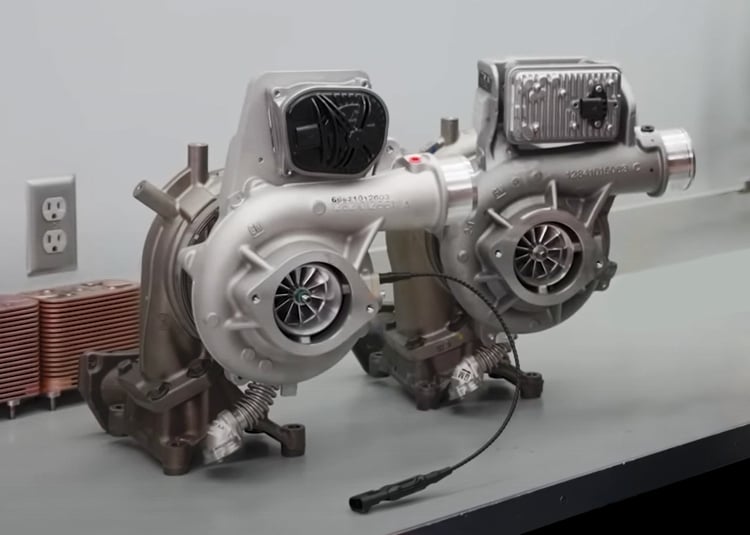
At a quick glance, you may not notice much of a difference between the L5P's previous turbo and the updated 2024 version. However, as you will see there are quite a few differences that will make the new model not directly compatible with the previous generation Duramax L5P engines. The first and most obvious is the difference in turbine housings.

Turbine Housing
The previous generation turbo used four evenly spaced holes in the mounting flange of the turbine housing. The new 2024 model still uses four holes however, one is slightly offset and will not line up to the old pedestal's hunting hole. This is done to more easily clear the v-band clamp of the turbine housing during installation. The turbine housing mounting flange has also been shortened in length, making it completely incompatible with last last-generation turbo pedestal. However, there is some hope for adaptability. The turbo pedestals themselves appear to have the same mounting positions in the valley of the engine along with having the same up pipe mounting configuration. This means that a 2024 turbo could be adapted to mount to a previous-generation engine using the 2024 turbo pedestal. Another small change that we see is in the design of the intake port of the turbine housing. This port seems to have been opened up more on the newer generation as it features a much more straight side compared to its previous fully oval-shaped design. We measured the surface area of the bore on the 2024 to be 353.2cm2 compared to 343.4cm2 on the previous generation.
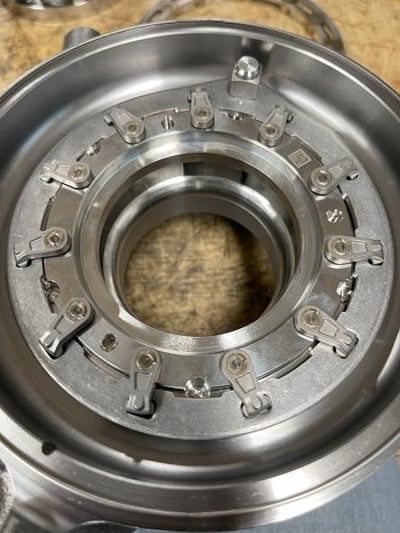 Vane Cage
Vane Cage
As we move from the outside of the turbine housing in we see that the previous generation vane cage has been replaced with an all-new design. This new style of vane cage features a simpler and better-designed vane cage assembly. The unison ring, which is used to transmit the motion of the actuator arm into all of the individual vanes, is now made from a single piece of stamped steel. The vanes themselves now have arms that fit into stamped holes around the unison ring which transmit the motion from one to the other. While the previous generation utilized a unison ring with pegs that were inserted into forks at the end of each vane.
The biggest difference between the two is the vanes themselves. The last generation turbo utilized (13) 9.4mm vanes while the new generation uses (11) 11mm blades. Not only does this enlarge the gap that exhaust gasses have to pass through, it also reduces the number of vanes that are in that path. Further enhancing overall flow and efficiency. This actually brings an improvement to efficiency very similar to that of the upgraded vanes that we utilize in our upgraded line of Stealth L5P turbos. We are very excited to see how these vanes perform compared to our current High-Flow Vane technology (HFV) and how much of an improvement we can make to the design of this vane cage.
Another slight yet impactful difference in the vane cage design is the pins which hold the vane cage in a fixed location. The last generation featured two locator pins which were located on the inside of the turbine housing and stuck into the bottom of the vane cage. The 2024 model uses 3 locator pins that stick out of the center section and into the top of the vane cage. This makes utilizing the older style of vane cage in these new turbos nearly impossible.
 Turbine Wheel
Turbine Wheel
With the larger vane height of the updated vane cage, the turbine wheel of the 2024 is certain to see changes as well. We found that the inducer height of the new turbine wheel is now 12mm to closely match the 11mm gap of the vane cage. The previous generation featured a 10.8mm inducer height to go along with its 9.4mm vane cage gap/opening. However, the most dramatic change we see to the turbine wheel of the 2024 is the move from an 11-blade wheel to a higher-flowing 10-blade wheel. While 10-blades will not be efficient down low it will certainly improve top-end performance when flow is at its highest. Another change we see to the updated turbine wheel is the use of cut-back turbine blades. Cut-back blades taper in height as you get further from the center of the turbine wheel. This design also improves the flow and top-end efficacy of the turbine wheel. Below you can find a chart that shows all of the comparative measurements for the two different turbine wheels.
|
Turbine Wheel |
2017 |
2024 |
| Inducer Diameter |
70.11mm |
70mm |
| Inducer Height |
10.8mm |
12mm |
| Blade Height |
29.55mm |
26.8mm |
|
Exducer Diameter |
62.54mm |
63.95mm |
|
Blade Count |
11 |
10 |
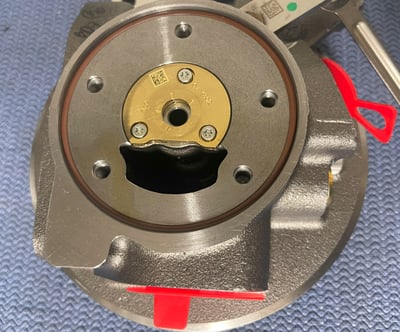
Center Section
With the turbo completely taken apart we can see that there are some differences between the two. The first and most obvious is the use of a new cast aluminum backing plate for the compressor cover which replaces a large amount of the steel center section that used to act as a backing plate on the previous generation turbo. This new backing plate attaches to the center section using 5 bolts and seals the oil inside the turbo using an o-ring around the parameter of the center section.

Both chargers utilize journal bearings in their design however the new 2024 model has gone from using a floating 360º thrust bearing to now using a fixed 360º thrust bearing that mounts to the center section using 3 Philips head screws. Since the thrust bearing is no longer held in by the oil galley plug and snap ring a new O-ring has been designed for the compressor side of the center section which is sandwiched between the baking plate to contain the oil. Another notable change is the addition of an oil deflector to the underside of the 360º thrust bearing. We suspect this is to help drain oil back into the center of the center section and not into the space between the backing plate and the center section.

Compressor Wheel
When the L5P first launched it came with a new 61.1mm billet compressor wheel which replaced cast 6+6 blade wheels we saw on the LML. This new compressor wheel took many of the features we see in aftermarket performance turbos such as an 11-blade design which helps reduce surge and a fully billet construction which improves durability. The compressor wheel in the new 2024 builds on those already great improvements by adding extended tip technology to the mix. The extended tips of the compressor wheel help it move more air and improve the turbos' overall efficiency. Besides the addition of extended tip technology, we don't see much of a change to the compressor wheel. There are slight variations in measurements between the two which you can see represented below but overall we are left with an extremely similar compressor wheel. We will be interested to see what kind of a difference this makes to engine performance.
|
Compressor Wheel |
2017 | 2024 |
|
Inducer Diameter |
61.1mm |
61.3mm |
| Exducer Diameter | 83.1mm | 84.28mm |
|
Exducer Height |
6.99mm |
5mm |
|
Base Diameter |
84mm |
81.92mm |
|
Overall Blade Height |
31.2mm |
30mm |
|
Nose Diameter |
18.64mm |
18.22mm |
|
Blade Count |
11 |
11 |
|
Trim |
73.52 |
72.73 |
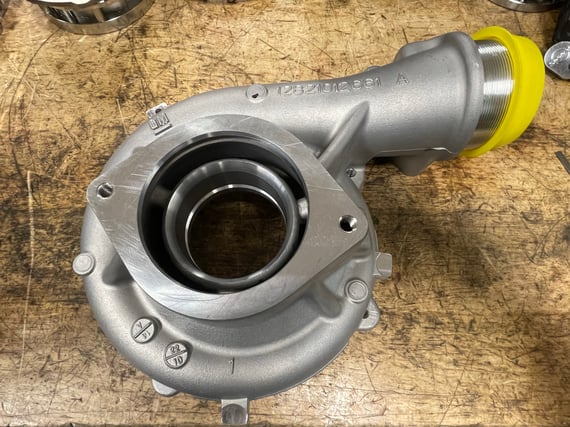
Compressor Cover
Since we already know that the compressor wheel has undergone slight size changes it's easy to assume the compressor cover has undergone some slight adjustments as well. On the new 2024, we see a slightly larger 62.7mm inducer bore compared to the previous 62.45mm inducer bore to make room for the .2mm larger compressor wheel inducer diameter. However, one of the most obvious changes we can see to the cover is the removal of the turbo actuator bracket. Instead, it has been relocated to the newly added cast aluminum backing plate for the compressor cover. The rest of the cover remains largely the same though, featuring the exact same mounting for the intake horn and charge pipe as the previous generation.
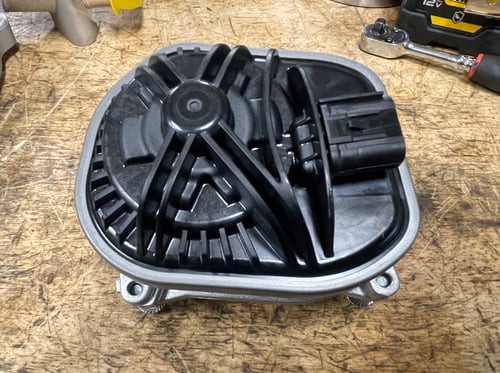
Turbo Actuator
One of the largest and most apparent changes to the 2024 turbo is the use of a new electronic vane actuator. Last year's turbo featured a beefy all-metal Borg Warner actuator that mounted directly to the compressor cover of the turbo. The 2024's actuator is still made by Borg Warner but is now much smaller and utilizes a partially plastic housing. However, this new actuator is reported to be much quicker and more powerful than the previous model. This theory should allow for quicker turbo vane adjustments, providing snappier turbo response and less lag. We are interested to see what the improved turbo actuator can provide in terms of tuning. This actuator does use the same style plug as the previous actuator so we will also be interested to see if the actuator is cross-compatible from a software standpoint. As testing continues we will update this article to let you know what we find on that front.
Be The First To Hear When Our 2024 L5P Stealth Mach 1 and Mach 2 Turbos Launch




